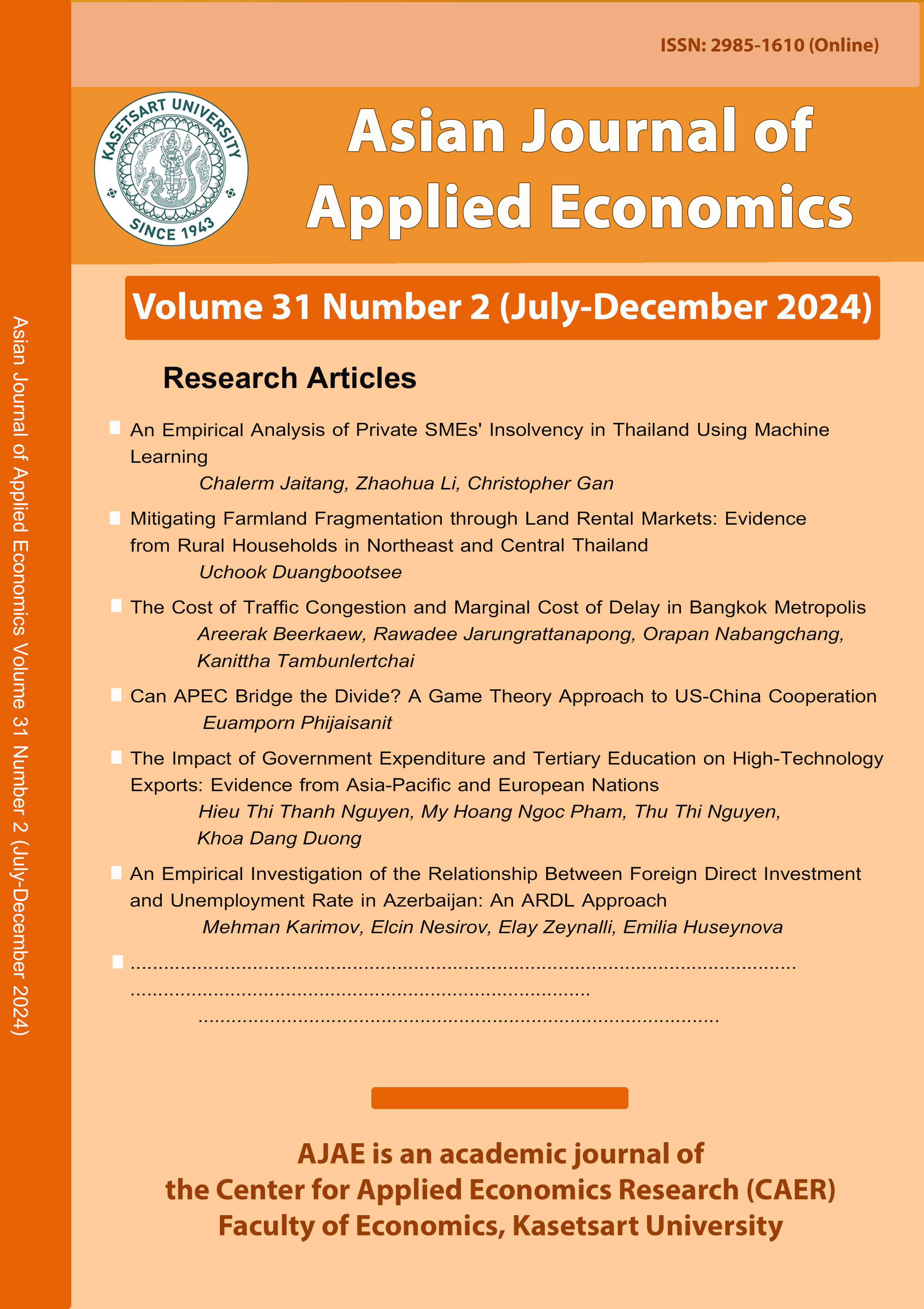The Impact of Bank Credit on Economic Growth in Lao PDR
Main Article Content
Abstract
This study examines the impact of bank credit on economic growth in Lao PDR from 1992 to 2022 using data from the World Development Indicators and the Bank of Laos. Employing the Cointegration and Error Correction Model (ECM) with the autoregressive distributed lag (ARDL) bounds testing approach, the results reveal that labor and bank credit to the private sector positively influence economic growth in both the short and long term, while credit to state enterprises has a negative impact. The findings suggest that the government should incentivize commercial banks to increase private sector lending and impose stricter regulations on state enterprise credit to mitigate non-performing loans (NPLs).
Article Details

This work is licensed under a Creative Commons Attribution-NonCommercial-NoDerivatives 4.0 International License.
The paper is published under CC BY-NC-ND, in which the article is freely downloaded and shared in its original form non-commercially and its citation details are identified.
References
Aurangzeb, D. (2012). Contributions of banking sector in economic growth: A case of Pakistan. Economics and Finance Review, 2(6), 45-54.
Banu, I. M. (2013). The impact of credit on economic growth in the global crisis context. Procedia Economics and Finance, 6, 25-30.
Barro, R. J. (1990). Government spending in a simple model of endogenous growth. Journal of Political Economy, 98(5, Part 2), S103-S125.
Beck, T., Demirguc-Kunt, A., & Levine, R. (2004). Finance, inequality, and poverty: Cross-country evidence (NBER Working Papers No. 10979). Cambridge , MA: National Bureau of Economic Research.
Duican, E. R. & Pop, A. (2015). The implications of credit activity on economic growth in Romania. Procedia Economics and Finance, 30, 195-201.
Engle, R. F., & Granger, C. W. J . (1987). Co-integration and error correction: Representation, estimation, and testing. Econometrica: journal of the Econometric Society, 55(2), 251-276.
Johansen, S. & Juselius, K. (1990). Maximum likelihood estimation and inference on cointegration - With applications to the demand for money. Oxford Bulletin of Economics and statistics, 52(2), 169-210.
Judith, M. N., Ugwuegbe, S., & Ugwuoke, R. O. (2014). The impact of bank credit on the growth of Nigerian economy: A co integration approach. Research Journal of Finance and Accounting, 5(10), 87-95.
Keats, R. (2015). How do banks fare during economic cycles? Retrieved from www.marketrealist.com
Korkmaz, S. (2015). Impact of bank credits on economic growth and inflation. Journal of Applied Finance and Banking, 5(1), 57-69.
Koivu, T. (2002). Do efficient banking sectors accelerate economic growth in transition countries? (BOFIT Discussion Papers, No. 14/2002). Helsinki: Bank of Finland.
Kyophilavong, P., Uddin, G. S. & Shahbaz, M. (2016). The nexus between financial development and economic growth in Lao PDR. Global Business Review, 17(2), 303-317.
Leitao, N. C. (2010). Financial development and economic growth: A panel data approach. Theoretical and Applied Economics, 10(551), 15-24.
Leitão, N. C. (2012). Bank credit and economic growth: A dynamic panel data analysis. Economic Research Guardian, 2(2), 256-267.
Rafindadi, A. A., & Yusof, Z. (2015). Do the dynamics of financial development spur economic growth in Nigeria’s contemporal growth struggle? A fact beyond the figures. Quality & Quantity, 49(1), 365-384.
Rahimzadeh, F. (2012). Banking sector, stock market and economic growth: Evidence from MENA countries. International Journal of Social Sciences and Humanity Studies, 4(2), 181-190.
Rebelo, S. (1991). Long-run policy analysis and long-run growth. Journal of Political Economy, 99(3), 500-521.
Skaggs, N. T. (1999). Adam Smith on growth and credit – Too weak a connection. Journal of Economic Studies, 26(6), 481-496.
Skaggs, N. T. (2003). H.D. Macleod and the origins of the theory of finance in economic development. History of Political Economy, 35(3), 361-384.
Thongwaroj, P. (2013). Analysis of relationship between financial development and economic growth of ASEAN Plus Three (Unpublished Master’s Thesis, Chiang Mai University). Chiang Mai: Thailand.
Timsina, N. (2014). Impact of bank credit on economic growth in Nepal. Nepal Rastra Bank Research Department, 22(1), 1-23.
Uddin, G. S., Sjö, B., & Shahbaz, M. (2013). The causal nexus between financial development and economic growth in Kenya. Economic Modelling, 35, 701-707.
Were, M., Nzomoi, J., & Rutto, N. (2012). Assessing the impact of private sector credit on economic performance: Evidence from sectoral panel data for Kenya. International Journal of Economics and Finance, 4(3), 182-190.
World Bank. (2007). Lao PDR economic monitor. Vientiane, Lao PDR: World Bank, Vientiane Office.
Yakubu, Z., & Affoi, A.Y. (2014). An analysis of commercial banks’ credit on economic growth in Nigeria. Current Research Journal of Economic Theory, 6(2), 11-15.
Ye, S., Zeng, J., Liao, F. & Huang, J. (2021). Policy burden of state-owned enterprises and efficiency of credit resource allocation: Evidence from China. Sage Open, 11(1), 21582440211005467 .


